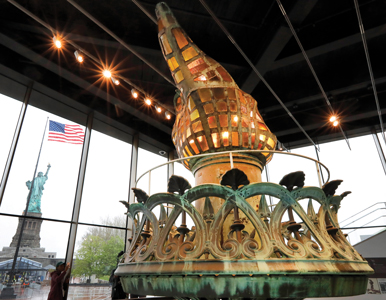
Alan Kraut was seven when his father—on a weeklong vacation from his job at a Manhattan factory—took the family to see the Statue of Liberty.
In May, Kraut was back on Liberty Island with Oprah Winfrey, Tony Bennett, and Hillary Clinton to celebrate the opening of the $100 million Statue of Liberty Museum—a 26,000-square-foot space that represents years of work for AU’s distinguished professor of history.
Kraut, a member of the Statue of Liberty–Ellis Island Foundation’s history advisory committee since the 1980s—and its chair since 2003—led a team of 14 historians that vetted every caption and image, reviewed rough cuts of the short documentary that greets museumgoers, and approved the space’s layout. The highlight of the design is a room containing the original torch, replaced in 1985, with stunning views of Lady Liberty.
The number one question the committee grappled with: “How do we help people understand liberty?” For the 4.5 million people who visit the 151-foot copper statue each year, the definitions differ.
“Liberty is, after all, an abstract concept. How much time and space do you devote to the conceptualization of the statue by [French jurist and politician Edouard Rene de] Laboulaye, to the building of the statue, to the design of the statue by [Frederic Auguste] Bartholdi?” Kraut asks. “Like all good museums, it’s a combination of education, engagement, and entertainment. Not everybody who comes to the museum is a college student; you’ve got families and kids of different ages.”
In addition to the statue’s 133-year history, the museum explores its complexities and ambiguities. Built to commemorate the abolition of slavery—note Lady Liberty’s left foot positioned atop broken shackles—the statue has long been associated with immigration due to its proximity to Ellis Island, which opened in 1892, and Emma Lazarus’s 1883 poem “The New Colossus,” which is inscribed on the pedestal. To some, including African Americans and suffragettes, the statue seemed to contradict reality and served as a symbol of America’s shortcomings.
“As late as the 1960s, James Baldwin called it a joke. W. E. B. Du Bois scoffed at it, understandably so,” Kraut says. “There’s a contradiction here. We’re celebrating liberty, even as some communities within our own country are being denied liberty.”
Ground was broken on the new museum in 2016 and the committee spent an “intense” last year finalizing captions and display text.
“Because the Statue of Liberty has come to symbolize America and is sacred to so many, the museum had to be done right,” Kraut says. “A group of dedicated scholars and museum professionals put other things on hold to make sure this new museum brought the contested concept of liberty and the statue’s story to the millions who visit each year. For this grandchild of immigrants and an American historian, it was an honor to be involved.”